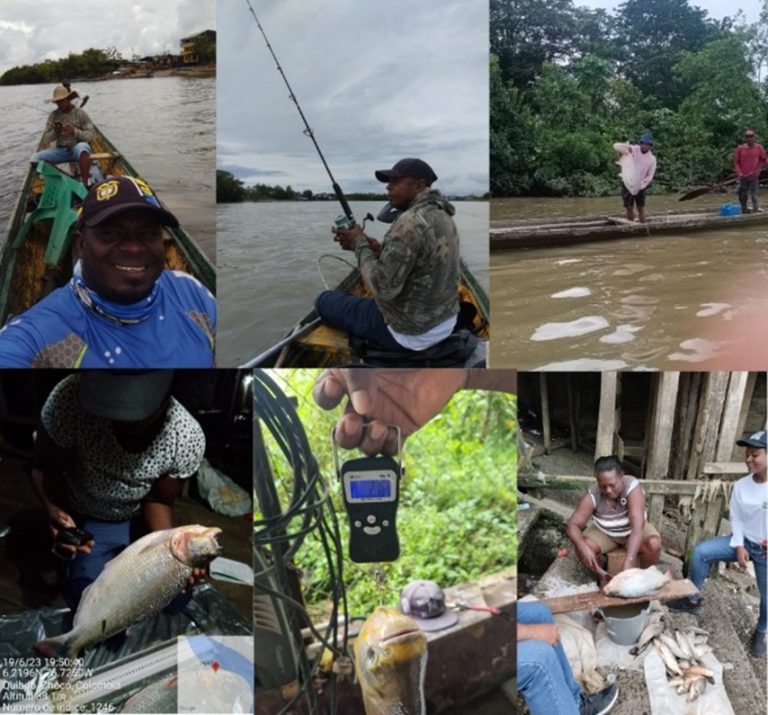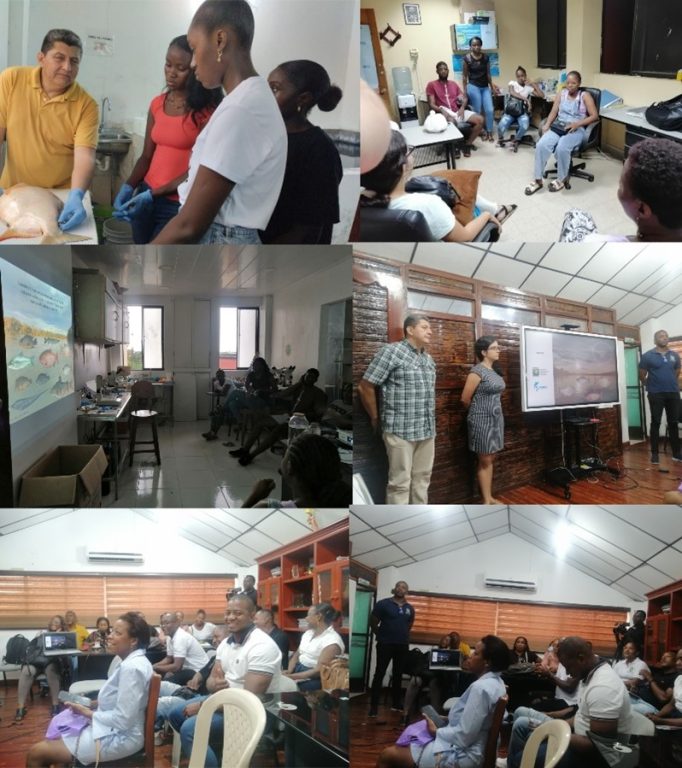Community participatory monitoring for the management of non-native fish species in the Atrato River, biogeographic Chocó, Colombia
22.04.2024
SUBMITTING ORGANIZATION
Foundation for research and sustainable development (FUNINDES)
DATE OF SUBMISSION
12/4/2024
Region
Americas
Country
Colombia
KEYWORDS
Artisanal fishers, Non-native fish species, sport fishers
AUTHOR and AFFILIATIONS
Angie Patiño-Montoya1; Zulmary Valoyes2; Eladio Renteria2; Rubén Darío Morales-Gamba1; Armando Ortega-Lara1
1FUNINDES (Foundation for research and sustainable development); 2Pacific Environmental Research Institute John Von Neumann (IIAP)
Summary Sheet
The summary sheet for this case study is available here.
BACKGROUND
Non-native species are those whose presence in a region is deliberately or inadvertently attributed to human activities (Psyek et al., 2020). In a non-native region, non-native species go through a series of stages called transport, introduction, establishment and dispersal (Blackburn et al., 2011). At each stage, the physical, biological or ecological barrier phases, define whether the population becomes established (constant reproduction that maintains recruitment without migration) and disperses, becoming invasive (Blackburn et al., 2011; Pysek et al., 2020). Therefore, the study of non-native species should be conducted as early as possible to determine their invasive potential and prevent potential social, economic and environmental impacts.
For the management of invasive fish species in rivers, must be consider the nature of the invasion. Invasive fish species can be introduced accidentally through escapes from aquaculture farms or intentionally with a direct introduction in places where these have a high economic and social value (Gozlan et al., 2010). The established non-native fishes can impact environments at different ecological scales (individual, population, community and ecosystem) (Vitule et al., 2009; Gozlan et al., 2010; Cucherousset and Olden, 2011). Economic value and food for the human communities, and life history traits of non-native fish influence the successful for the establishment in rivers (Bernery et al., 2022) and determines the speed of the invasion. Thus, the invasion success of invasive fish in rivers is determined by the species, the environment, and anthropogenic factors.
In Colombia, aquaculture began in 1939 with the culture of a non-native trout Oncorhynchus mykiss in the Andes (Walbaum, 1972). Currently, non-native fish represent 70% of national production, with 30% being the production of white cachama (Piaractus brachypomus Cuvier, 1818), yamú (Brycon amazonicus Spix and Agassiz, 1829) and bocachico (Prochilodus magdalenae Steindachner, 1879) (Cruz-Casallas et al., 2011). For these reasons, doradas (Brycon moorei Steindachner, 1878) and cachamas (Colossoma macropomum Cuvier (1816), and Piaractus spp.) have been transplanted in other basins of the Colombian territory (Gutierrez et al., 2012).
For more than 20 years in the Atrato basin in Chocó Colombia, non-native species such as the black cachama (Colossoma macropomum), white cachama (Piaractus brachypomus), and tilapia (Oreochromis spp.) have been commonly captured. The cachama and tilapia were accidentally introduced to the Atrato River as a food security strategy and possible mitigation in areas disturbed by mining (Gutiérrez et al., 2012). Therefore, knowledge about non-native fishes in the Atrato River is necessary to protect it.
SOCIOECONOMIC, ENVIRONMENTAL CHARACTERSTICS OF THE AREA
The Atrato River allows regional integration, fulfills functions linked to the provision of livelihood and trade for a large part of the Chocó population. The way of life of the black and indigenous communities in the region depends largely on the supply of natural resources through activities such as fishing and fish farming, which correspond to subsistence economies (Lasso et al. 2011).
The Atrato River basin has an area of 38 km2, a length of 750 km, and a navigability of 508 km (Lasso et al. 2011). Although the Atrato River flows into the Caribbean Sea, the watershed is in the department of Chocó. The Chocó region has an approximate relative humidity of 86%, temperature between 28°C and 32°C, with annual rainfall between 8,000 and 10,749 mm, and tropical rainforest ecosystems (Rivas-Lara et al., 2017).
The introduction of non-native freshwater fish species changes the human-nature relationship. One change consists in the natural perception of people about the native freshwater fishes. Another change consists of the disruption of fisheries because of the commercialization of non-native freshwater fishes. The non-native freshwater fishes generally are bigger, therefore, more sellers than native freshwater fishes. This situation could produce more introductions in the river, for the called “pervasive incentive”.
OBJECTIVE AND RATIONALE
- Objective: Promote the artisanal and sport fishers’ engagement in the control of non-native freshwater fish species in the Atrato River.
- Outcome: Artisanal and sport fishers’ participation in management activities of non-native freshwater fish species.
- Objective: Identify the non-native freshwater fish species in Atrato River with the help of artisanal fisherman and sport fishers.
- Outcome: Non-native freshwater fish species identified in Atrato River.
- Objective: Establish the potential impact of non-native freshwater fish species in Atrato River, for the implementation of control measures.
- Outcome: Impact of non-native freshwater fish species established in the Atrato River, and governmental control measures implemented.
- Objective: Evaluate the perceptions of artisanal and sport fishers about the non-native freshwater fish species in the Atrato River
- Outcome: Warn/ Awake the artisanal and sport fishers about the problematic of non-native freshwater fish species in Atrato River.
DETAILED DESCRIPTION OF ACTIVITIES
Community participatory monitoring consisted of fishing of cachamas and doradas by the community in Quibdó and Tagachi, which were received by data collectors (Figure 1). The data collection consisted of watching for the arrival of cachamas and doradas. Each specimen was treated in four steps; first, standard length and weight measurements were taken. Second, a pelvic fin sample was taken and preserved in 96% ethanol. Third, with the respective permission of the owner of the specimen, the stomach and gonads were extracted. Finally, the stomach and gonads were preserved in 20% formalin for subsequent transfer to the FUNINDES laboratory in Cali. In laboratory, the cachamas and doradas were identified by molecular analysis, and their life histories attributes (feeding and reproduction) were established with the analysis of stomach and gonads.

Conceptual framework of satoyama initiative: The artisanal and sport fishes is a socioeconomic activity. This activity could be used to conserve the native fishes, encouraging the fishers to take advantage of non-native fishes. In this way, the abundance of non-native fishes could be controlled in the river, the fisheries could be sustainable, and the native resource protected.
RESULTS AND LESSONS LEARNED
The pilot of community participatory monitoring of non-native fishes was made with success. The artisanal and sport fishers from Quibdó and Tagachí help in the fisheries of cachamas and doradas. The sport fishers reported stories about the introduction of these fishes in the Atrato basin, with aquaculture as a principal origin. The people in this region seem to understand the importance of control the abundance of non-native fishes, such as Tilapia (Oreochromis niloticus).
As a product of this community participatory monitoring, we identified in the Atrato River three cachamas and one dorada. The cachamas were identified as Colossoma macropomum, Piaractus brachypomus, and Piaractus orinoquencis, species native to the Amazonian and Orinoco River basins. The dorada was identified as Brycon sinuensis, a species native to the Sinú River basin. A total of 21 cachamas (20 Piaractus spp. and 1 Colossoma macropomum) and 47 doradas (Brycon sinuensis) were collected during community participatory monitoring from June 01 to September 07, 2023. The cachamas were only recorded in Quibdó, while the doradas were recorded in Quibdó and Tagachi. The cachamas and doradas are omnivores tending to hervibovire, and their reproduction in nature is possible.
In the future, community participatory monitoring must be extended to all Atrato River basin. In this way, we can establish the impact of these non-native fishes on the people and nature. The public order situation in the Chocó region is complicated by armed conflict, it could be the principal limitation to coordinating the artisanal and sport fishers as other stakeholders (fish sellers, fish buyers, IIAP). This armed conflict could limit the activities along the project but is possible.
KEY MESSAGES
- This work is an early warning about the lack of control in the introduction of fish in the Atrato River basin, in addition to the potential impact of a possible establishment of non-native fishes.
- It is recommended to avoid future introductions and to manage what is already present in the river. Introductions are avoided by reconstructing the route from the practice that introduced them (e.g. aquaculture) to the new area.
- For the management of specimens in the river, community participatory monitoring should be established to collect fish larvae and control the population through fishing. These activities would consist of monitoring that covers both low and high waters in the entire Atrato river basin.
- The community would be involved in the monitoring, information gatherers would be trained, and scientific sampling would be carried out simultaneously. In this way, the management plan can be built on solid foundations and executed by all the stakeholders involved.

REFRENCES AND BIBLIOGRAPHY
Blackburn, T. M., Pyšek, P., Bacher, S., Carlton, J. T., Duncan, R. P., Jarošík, V., … y Richardson, D. M. (2011). A proposed unified framework for biological invasions. Trends in ecology & evolution, 26(7), 333-339
Bernery, C., Bellard, C. A., Courchamp, F., Brosse, S., Leroy, B. (2022). Important characteristics determining the success of nonnative freshwater fish introduction, establishment, and impact. hal-03563547
Cucherousset, J., Olden, J. D. (2011). Ecological impacts of nonnative freshwater fishes. Fisheries, 36(5), 215-230.
Gozlan, R. E., Britton, J. R., Cowx, I., Copp, G. H. (2010). Current knowledge on non‐native freshwater fish introductions. Journal of fish biology, 76(4), 751-786.
Gutiérrez, F. de P., Lasso, C. A., Baptiste, M. P., Sánchez-Duarte, P. y Díaz, A. M. (Eds). (2012). VI. Catálogo de la biodiversidad acuática exótica y trasplantada en Colombia: moluscos, crustáceos, peces, anfibios, reptiles y aves. Serie Editorial Recursos Hidrobiológicos y Pesqueros Continentales de Colombia. Instituto de Investigación de los Recursos Biológicos Alexander von Humboldt (IAvH). Bogotá, D. C., Colombia, 335 pp.
Lasso, C. A., F. de Paula Gutiérrez, M.A. Morales-Betancourt, E. Agudelo, H. Ramírez -Gil y R. E. Ajiaco-Martínez (Editores). 2011. II. Pesquerías continentales de Colombia: cuencas del Magdalena-Cauca, Sinú, Canalete, Atrato, Orinoco, Amazonas y vertiente del Pacífico. Serie Editorial Recursos Hidrobiológicos y Pesqueros Continentales de Colombia. Instituto de Investigación de los Recursos Biológicos Alexander von Humboldt. Bogotá, D. C., Colombia, 304 pp.
Pyšek, P., Hulme, P. E., Simberloff, D., Bacher, S., Blackburn, T. M., Carlton, J. T., … y Richardson, D. M. (2020). Scientists’ warning on invasive alien species. Biological Reviews, 95(6), 1511-1534.
Rivas-Lara, T.S., Mosquera-Murillo, Z., Vidal-Mosquera, M., Gómez-Vanega, H. (2017). Aproximación al conocimiento de los peces y las pesquerías en el río Atrato en el marco del proyecto “Diseño e implementación de protocolos de producción de especies ícticas nativas de la cuenca del Atrato”. Universidad Tecnológica del Chocó, Quibdó, Colombia, 202 pp.
Vitule, J. R. S., Freire, C. A., Simberloff, D. (2009). Introduction of non‐native freshwater fish can certainly be bad. Fish and fisheries, 10(1), 98-108.
WEB LINKS OF ANY RELEVANT ORGANIZATIONS AND PROJECTS
Pacific Environmental Research Institute John Von Neumann
RECOMMENDATIONS FOR FURTHER READING
This study case is a summary. All the results of these activities will be published as a research paper.
AUTHORS' PROFILES
Angie Patiño Montoya: Biologist from the Universidad del Valle and a PhD in Ecology from the Universidade de Brasilia (UnB). Her main research interest is biological invasions. Her research has focused on the management of introduced fish in Colombian Pacific River basins, as well as the conservation of the national fisheries resource.
Zulmary Valoyes and Eladio Renteria: They are biologist focused on the conservation of biogeographic Chocó biodiversity and the ecosystem services derived for them.
Ruben Dario Morales-Gamba: Animal scientist with an MSc in aquaculture and a PhD in Zoology. His research has focused on the reproduction physiology and reproduction endocrinology of fishes and elasmobranchs.
Armando Ortega Lara: Biologist and a PhD in Biology from the Universidad del Valle. His main research interest is in neotropical freshwater fish taxonomy and evolution. His research has focused on the description of several fish species and the management of Colombian fisheries resources.

